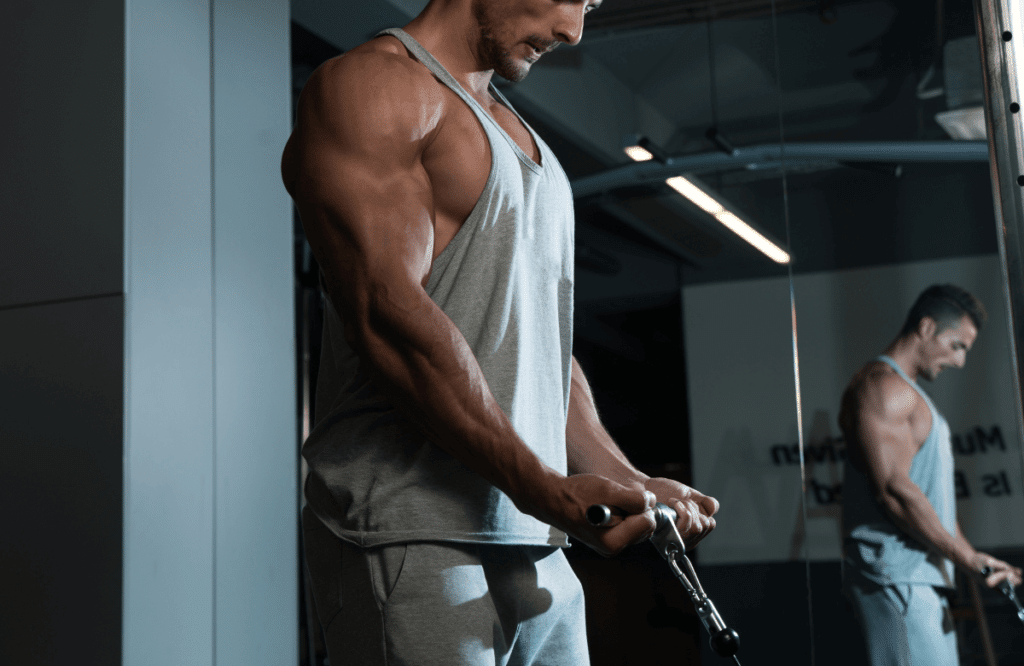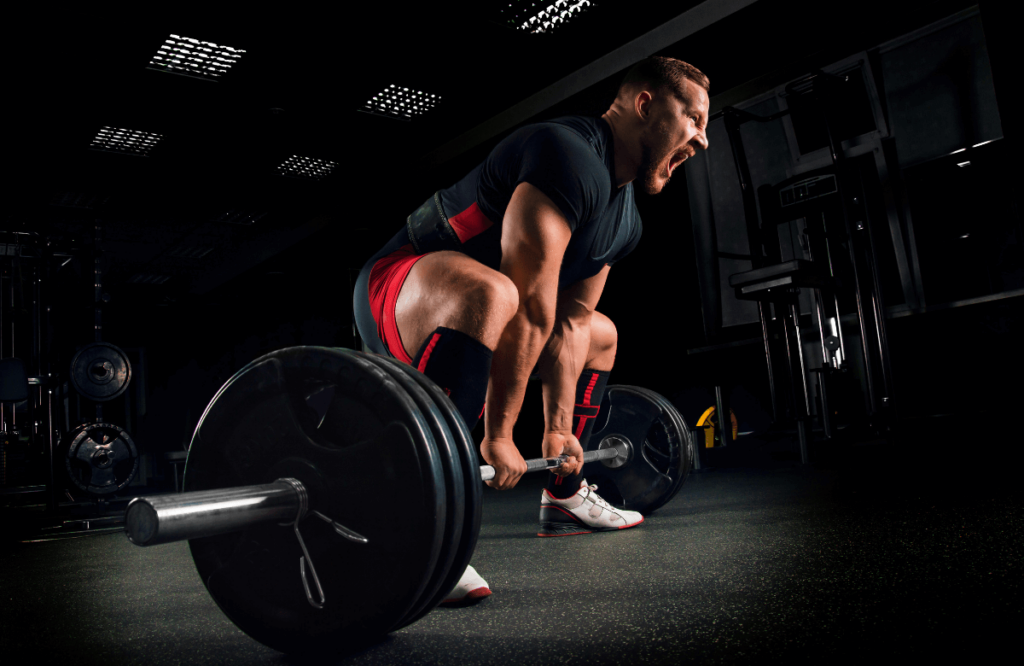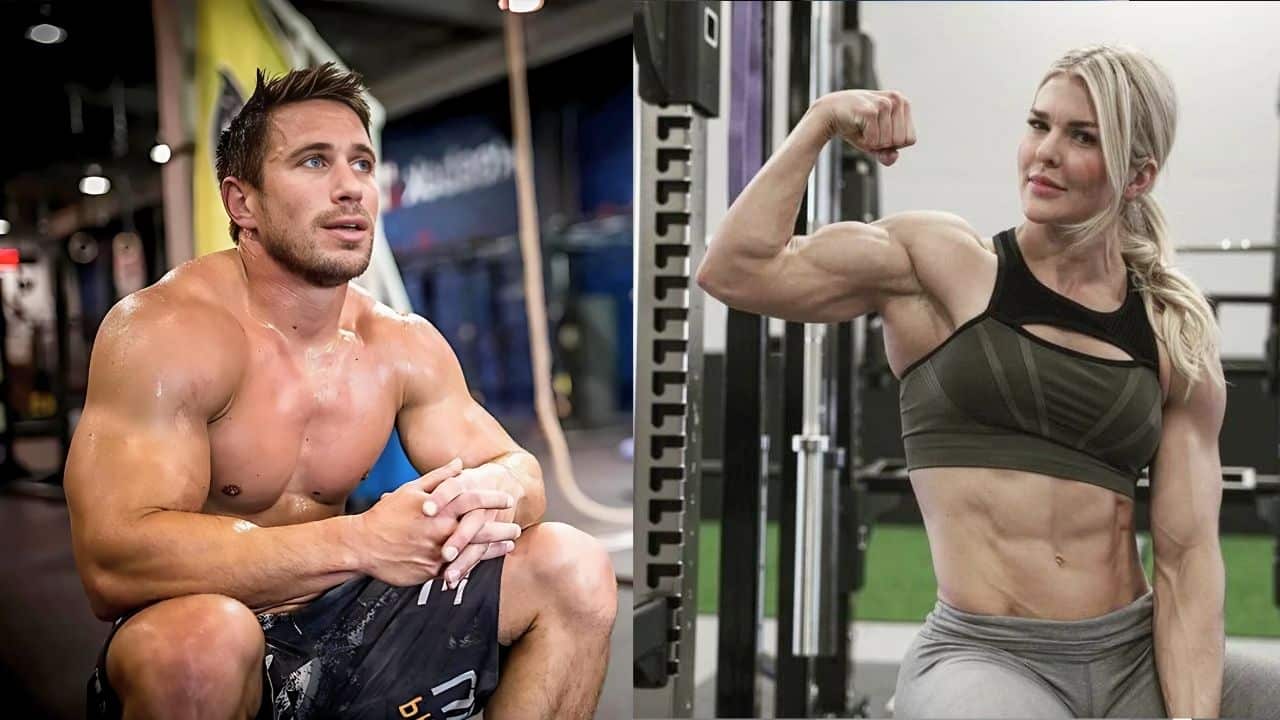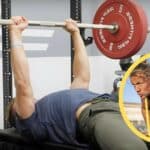As the saying goes, “Curls get girls.” Huge biceps are a dream for many lifters but can be a challenge to obtain. Without the proper techniques, you may have a prominent bicep peak but little width.
So, how to get wider biceps? Let’s look at everything you need to know so you can achieve bowling ball biceps.
Jump to:
Understanding Biceps Anatomy

The first step to getting wide biceps is understanding biceps anatomy. The biceps brachii is a single muscle located on the front of the arm and composed of two muscle heads (two-headed muscle). This is where the “bi” in the biceps comes from.
The biceps muscle has three primary functions, including the following:
- Bending the elbow
- Turning the palm up
- Raising the arm forward
The two biceps heads are known as the long head and short head.
Both bicep heads work in tandem, but it’s possible to engage one more than the other during bicep training.
The long head, which is found on the exterior of the biceps muscle, contributes to the biceps peak.
The short head, which is on the inner section of the muscle, contributes to the overall thickness and width. So, if you want wider biceps, you should prioritize biceps exercises that target the short head.
The Brachialis
But there’s another muscle that plays a role in arm size—the brachialis.
The brachialis is an elbow flexor, meaning its job is to bend the arm. The brachialis does not play a role in shoulder flexion or forearm supination. In fact, the biceps serves as a support for the brachialis muscle whenever you lift or lower the forearm.
The brachialis muscle is beneath the biceps, making it less visible. It’s a critical muscle, and strengthening it will allow you to lift heavy weights. A bigger brachialis will also support your lower bicep, making it look wider.

How Much Weight Should You Lift?
So, now you understand targeting the short head of the bicep muscle will give you thicker and wider biceps—but what about the weight, intensity, and rep range?
Heavier weights will place more pressure on the elbow joint, leading to a higher chance of injury and strain. Instead, it’s better to use lighter weights for more repetitions, commonly called hypertrophy training.
Lighter weights for more repetitions lead to more biceps muscle growth, endurance, and size.
But what is a lightweight for biceps training? Generally, you should opt for weights around 60-80% of your one rep max. We don’t recommend finding out your one rep bicep curl max unless you want extra stress on the elbow joints.
Instead, focus on the amount of reps you can do with a specific load.
How Many Reps?
Training in the 4-6 rep range will yield strength and speed gains without much effect on the overall muscle size—which isn’t what you’re after.
Anything over the 15-rep range will improve endurance but won’t yield many results in strength or size.
Instead, aim for the 8-12 rep range for optimal bicep muscle growth. You can also include a few lower rep sets or higher sets of 12-15 reps to stimulate as many biceps muscle fibers as possible.

How To Get Wider Biceps: The 10 Best Exercises
It’s not possible to completely isolate the short head of the bicep, but there are techniques you can use to engage it more during bicep exercises.
The main factors to keep in mind during your biceps workout include the following:
- Curl using a wide grip.
- Curl using a supinated grip (palm facing upward and outward)
- Curl with the elbows in front of the body.
These factors will be essential to keep in mind so you get the most out of your biceps workout routine. Now let’s look at some exercise selections you can incorporate into your bicep training for developing more muscle mass.
1. Wide Grip Barbell Curl
The traditional barbell curl is a classic exercise. The movement allows you to go a bit heavier, helping you build size and strength. Switching to the wide-grip barbell curl variation allows you to target the short head of the muscle, helping you develop more width.
You’ll need to experiment with the grip width to see what works for you, but it’s typically recommended to move the hands beyond shoulder width.
- Load a straight barbell with weights you can lift for 8–12 reps.
- Use an underhand grip that’s slightly wider than shoulder-width apart.
- Maintain a straight stance with tight abs and a slight bend in the knees.
- Now, bend your arms to curl the barbell to shoulder height. Maintain straight writs and avoid using the legs or back.
- Lower the barbell back down to the starting position to finish one rep.
2. Preacher Curls
The preacher curl is another classic biceps curl. The movement has countless options, like the barbell, cable, and dumbbell preacher curl variations. With a wide grip, you can target the inner bicep and build more muscle strength.
For this example, we recommend using an EZ Curl Bar and a preacher bench. Here’s how:
- Grab an EZ Curl Bar with weights you can comfortably lift for 8–12 reps.
- Sit at the preacher’s curl bench. Do not roll your shoulders forward over the bench. Instead, maintain a straight posture with the chest out and triceps against the bench.
- Now, gently lower the weights until the forearms are near fully extended. Do not fully extend the arms to avoid elbow injury.
- Curl the weight up and maintain tension in the biceps to finish the rep.
3. Spider Curls
Spider Curls, or prone incline curls, are a fantastic way to develop the arms. This movement requires an adjustable bench but offers a wider range of motion. The wider range of motion makes it more challenging, helping you build stronger biceps.
- Position an adjustable bench to roughly 45 degrees. Lie face down on the bench with your arms hanging straight toward the floor.
- With dumbbells, a barbell, or EZ Barbell, curl the weight toward the shoulders.
- Slowly lower the weight to finish the repetition.
4. Incline Curls
Another curl variation to try is the incline curl. The incline dumbbell curl targets the short head of the bicep, providing a fantastic way to stretch and develop the muscle. It requires an adjustable incline bench.
- Adjust an incline bench to approximately 55-65 degrees. Select a weight you can comfortably lift for 8–12 reps and sit upright with your back flat against the incline bench.
- Now, with a supinated (palms facing up), take a deep inhale and curl both hands towards the shoulders.
- Maintain a tight core through the entire range of motion and slowly lower the weights to the starting position to finish one repetition.
5. Concentration Curls
For a classic dumbbell variation, try the concentration curl. This movement is executed by leaning forward, sitting down, or standing. The forward position places the arm ahead of the body, which emphasizes the short head of the bicep.
- Select a dumbbell weight where you can execute 8–12 reps comfortably.
- Sit on a flat bench with a straight torso and feet flat on the ground. Keep the knees slightly wide.
- Lean forward with the elbow resting on your inner thigh.
- Position your open hand on the opposite knee to balance the body while gripping the weight with the palms facing up.
- Take a deep breath in and curl the dumbbell towards the shoulder.
- Pause at the top before slowly lowering the weight to finish the rep. Repeat the movement on the opposite arm.
7. Zottman Curls
Zottman curls are an old-school movement that combines reverse curls and regular curls. This trains your biceps and brachialis simultaneously, helping you develop larger arms. You can perform Zottman curls seated or standing.
- Grip a dumbbell in each hand with the arms at your sides and palms facing the legs. Keep an upright torso and tight core.
- With the arms near the sides, bend the elbow and curl the weights to shoulder height.
- Before lowering the weights, rotate the forearms so your palms are facing the floor.
- Extend the arms and lower the weight toward the starting position.
- Repeat the movement for 8–12 repetitions.
8. Dumbbell Hammer Curls
Hammer curls are another classic bicep curl variation that emphasizes the brachialis and short head of the muscle. The movement gets its name because it looks like you are hammering a nail when performed correctly. There are several variations, including dumbbells, cables, cross-body, and more.
- Grip a dumbbell in both hands with the arms at the side. Keep the palms facing in a neutral position, facing inward toward the thigh.
- With a tight torso and core, curl the weight to shoulder height. Maintain a neutral grip throughout the entire movement.
- Slowly lower the weight to the starting stance and repeat with the opposite hand.
9. Cable Curl
The cable biceps curl may look like a standard curl, but the cable machine offers several benefits compared to free weights. The cable curl provides consistent tension throughout the entire range of motion, which challenges the biceps even further.
The different handle options can also offer varying grip widths, which can help you target the short head.
- Attach a rope or handle of your choice to the lower position of a cable machine. Grab the rope with a neutral grip and take a few steps backward.
- With a straight torso and tight core, curl the rope towards the shoulders.
- Carefully lower the weight to finish one repetition.
This is also a fantastic movement to consider doing in the 12–15 rep range, as the cable machine offers consistent tension throughout the entire exercise.
10. Chin-Ups
Yes, there’s an exercise on our list that isn’t a curl. The chin-up is a fantastic movement for developing the upper body, including the biceps. You can do a wide-grip variation to emphasize the short head and adjust the difficulty with weights or resistance bands.
- Grip the chin-up bar with an underhand grip about shoulder-width apart.
- Now, hang for a moment allowing the body to be long and the elbows slightly bent.
- Maintain a tight core and pull yourself up, engaging the lats, shoulders, and biceps until the chin goes over the bar.
- Slowly lower yourself down, maintaining control to finish one repetition. You can adjust the amount of reps depending on your fitness level.
Common Mistakes to Avoid
When training arms muscles, it’s tempting to pick up any old weight and swing it wildly, hoping for the best. But like any other muscle, it’s critical to avoid common mistakes during your bicep workouts. Here are a few common pitfalls to look out for and avoid.
Excessive Swinging
Excessive swinging and movement during a bicep curl is a classic pitfall to avoid. Excessive swinging is typically caused by heavy weights, causing the lifter to overcompensate with other muscles.
Instead, use moderate weights you can lift for 8–12 reps for 3–5 sets of curls.
Maintain control throughout the movement with a tight core and torso. This will ensure you’re engaging the biceps and reduce the risk of injury.
Using the Same Grip Width
It’s common for lifters to find a grip width they’re comfortable with and never deviate. Although this will help you perfect your lift, you’re doing your biceps a disservice.
Adjusting your grip distance will add variety to your workouts but engage the muscle in a different way.
A wider grip will target the short head of the bicep, helping you achieve a thicker bicep. A shorter grip will engage the long head of the bicep, giving you a larger peak and a fuller bicep.
Too Much Elbow Flare
When executing bicep exercises, make a note of your elbows. As you lift the weight, ensure the elbows are parallel with the ground for the first 90-degree angle of the elbow flexion. If you’re using too much weight, you may flare the elbows too much.
Too much flare in the elbows can cause injury and stress to the joints and utilize the muscles less effectively.

Overtraining
Overtraining the biceps is another common pitfall.
The biceps are used as supporting muscles for other movements, like compound exercises. If you incorporate too many isolation exercises, you may overtrain the muscle, increasing the likelihood of injury, strain, or burnout.
Always make a note of your body and make adequate time for recovery. Depending on your workout schedule, it may be wise to train the biceps 2–3 times per week. You may only want to perform 1-2 exercises or 3-5 exercises per session, depending on your training schedule and goals.
It’s also important to incorporate dedicated rest days, whether it’s a day off from the gym or a day where you target different muscles.

Nutrition and Recovery Considerations
The quest for larger biceps doesn’t only include exercise variations—you need the correct nutrition and recovery techniques for the best results.
Eat Enough Protein and Calories
All muscle growth, including bicep growth, requires a caloric surplus and adequate protein intake. The body needs enough calories to gain muscle mass and protein for muscle development and recovery.
You can determine how many grams of protein and calories your body needs using online calculators.
An additional 300-500 calories per day may be recommended for muscle development, but this depends on your body composition, workout regimen, and fitness goals.
One gram of protein per pound of body weight is usually recommended for muscle growth.
The sources of protein are also important. Protein powder can be an excellent supplement, but lean meats like chicken, fish, turkey, beef, and pork are equally important.
Get Enough Rest
Besides dedicated rest days and 7–9 hours of quality sleep, taking rest between sets is also important.
Depending on your training routine, you may want to take a 45-second break between sets or even 1 to 2-minute breaks. This will ensure you’re giving your muscles enough time to recover between sets so you can execute the rest of your routine without burning out.

Frequently Asked Questions (FAQ)
How Do I Make My Biceps Wider?
Targeting the short head of the biceps muscle is typically recommended for wider biceps. You can engage the short head by using a wide grip in movements like the wide-grip barbell curl, preacher curl, and spider curl.
Why Aren’t My Biceps Wide?
Your biceps may not be wide due to a lagging short head. This is the muscle head on the inner portion of the bicep. You can target the short head with the movements listed above or by using a wide grip during curls.
What Gives Biceps Thickness?
The bicep is composed of two muscle heads, the short and long head. Theshort head of the bicep is traditionally believed to provide thickness. It’s located on the inner section of the muscle. The long head is on the exterior side, providing a larger peak. Using varying grips will give you fuller, thicker muscle.














